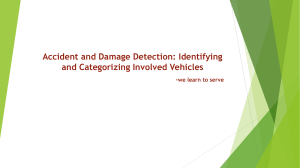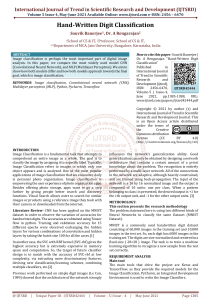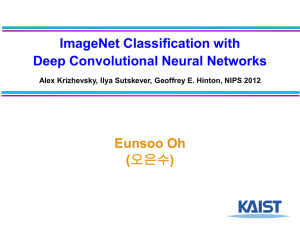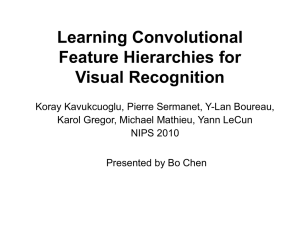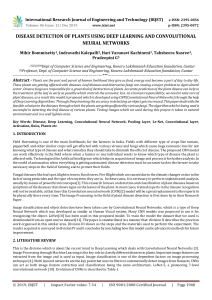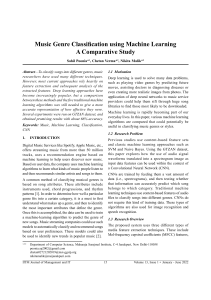human action classification using 3-d convolutional neural
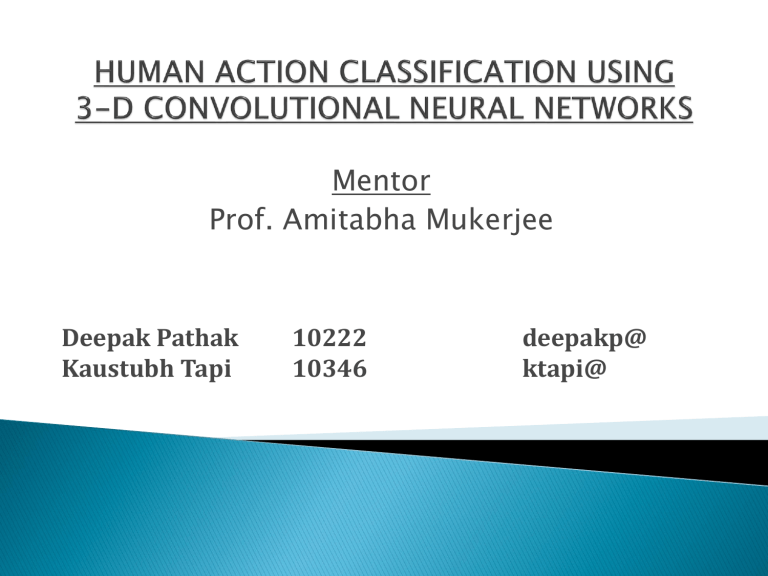
Mentor
Prof. Amitabha Mukerjee
Deepak Pathak 10222
Kaustubh Tapi 10346 deepakp@ ktapi@
Objective is to classify human actions from the video dataset.
• Motivation:
Current methods are highly image processing based and highly problem dependent. We’ll use 3-D Convolutional Neural networks which extracts and learns the features to classify different set of actions.
• Implemented on Weizmann Dataset of human actions which is classified into 10 actions.
[CREDIT: WEIZMANN DATASET]
• Firstly we break each video into its constituent frames and apply bounding box on each frame to reduce input dimension size.
• Dataset of 226 videos (10 classifications) was divided into training(181 videos) and testing part(45 videos).
• A subsequence of 13(64X48X13) consecutive frames with 12 frames overlap is given as input to 3-D Convolutional Neural Networks.
• Till now we have tested on silhouette frames of videos.
CREDIT: “Sequential Deep Learning for Human Action Recognition” Paper by: Baccouche, M., Mamalet, F., Wolf, C., Garcia,
C., Baskurt, A. [2011]
• For training the neural network , inputs from training set are forward propagated till the last layer[FORWARD PROPAGATION].
• Our 3-D Convolutional Neural Network undergoes supervised training.
• Error is computed in last layer and then propagated backwards to all previous layers.(BACKPROPAGATION).
• Weight updation in layers depends on eta(learning rate).
• Weights will converge after a number of epochs.
(Hessian Back-propagation used to reduce number of epochs)
• Learned feature maps seem to capture visually relevant information (person/background segmentation, limbs involved during the action, edge information. . . )
• Same learning algorithm used for entire 3-D Convolutional
Neural Networks
Input
Video
Silhouette
Frames
Output layer
(10 classifications)
Sub-sampled feature maps
(with bias)
Convolved feature maps
Recurrent
Neural
Network
We obtained code for 2-D Convolutional Neural Network for MNIST digit recognition(C++ Implementation) ) by Mike O’ Neill [3]
We modified the code to construct 3-D Convolutional Neural Network for Human action recognition on WEIZMANN DATASET.
Our code can be implemented from command line and number of nodes, layers and kernels can be modified easily.
Accuracy of 88%-90% was obtained on WEIZMANN DATASET(181 videos for training and 45 videos for testing) after a training of 8 epochs.
[1] Baccouche M., Mamalet F., Wolf C., Garcia C., Baskurt A. : “Sequential
Deep Learning for Human Action Recognition” . In: Salah, A.A., Lepri, B.
(eds.) HBU 2011. LNCS, vol. 7065, pp. 29–39. Springer, Heidelberg
[2011].
[2] Weizmann Dataset (std.).
[3] Code for 2-D Convolutional Neural Network for MNIST digit recognition(C++ Implementation) by Mike O’ Neill presented in paper by-
Patrice Y. Simard, Dave Steinkraus, John Platt, "Best Practices for
Convolutional Neural Networks Applied to Visual Document
Analysis," International Conference on Document Analysis and
Recognition (ICDAR), IEEE Computer Society, Los Alamitos, pp. 958-
962 [2003].
